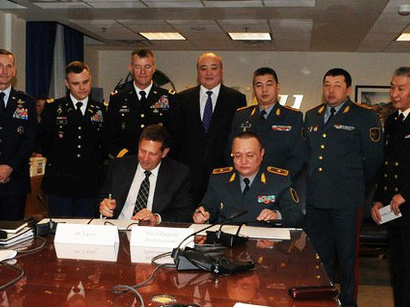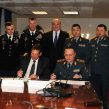
US Downsizes Military Ties With Central Asia
Publication: Eurasia Daily Monitor Volume: 11 Issue: 138
By:

In June 2014, Central Asian media (centrasia.ru, June 19; avesta.tj, kursiv.kz, June 20) widely republished a June 18 article by EurasiaNet that analyzed the United States Defense Department’s latest biannual report to Congress regarding the implementation of its Drug Interdiction and Counter-Drug Activities program in the first half of FY2014. The report asserts that US military and security aid to Central Asia has been steadily declining since 2012. It shows as evidence that the four local recipients of US anti-drug assistance—Kazakhstan, Kyrgyzstan, Tajikistan and Uzbekistan—received $8.7 million, $21.3 million, $15.4 million and $5.7 million, respectively, in FY2012. In contrast, their funding packages for the period between October 2013 and March 2014 have amounted to substantially lower levels: $187,000, $1.2 million, $1.1 million and $156,000 worth of funding, respectively.
A detailed analysis of the US Government’s foreign assistance data (foreignassistance.org, July 22) corroborates this dynamics by revealing sharp cuts in “peace and security” funding to Central Asia by all Executive Branch arms, first and foremost by the Pentagon. For instance, Kazakhstan’s peace and security package in 2012 stood at over $100 million, of which the lion’s share ($85.5 million) was channeled toward combating weapons of mass destruction. One year later, the budget shrank to $5.3 million, and a comparable amount has been earmarked for the current fiscal year. Similar reductions can be observed for three other states ($32.4 million in FY2012, $8.4 million in FY2013 for Kyrgyzstan; $36 million in FY2012, $11.1 million in FY2013 for Tajikistan; $34.8 million in FY2012, $3.2 million in FY2013 for Uzbekistan).
While the White House earlier said that it will leave a residual number of US troops in Afghanistan beyond 2014, namely in Kabul and at the Bagram airbase, its military cooperation with Central Asia no longer seems to be a priority. Until recently, Kazakhstan has been the key focus of US military assistance. The active phase of military cooperation between Washington and Astana actually goes back to the early 1990s when the Pentagon first played an instrumental role in the decommissioning of Soviet missiles on Kazakhstani territory. The two countries currently have a five-year military cooperation plan for 2013–2017 (today.kz, December 11, 2012). Last November, Kazakhstan’s former defense minister, Adilbek Dzhaksybekov, visited Washington where he stressed the importance of securing further US funding for the training of Kazakhstani soldiers (vpk.name, November 14, 2013). The same message was voiced by his successor, Serik Akhmetov, earlier this month (July 10) during a meeting with the US ambassador (inform.kz, July 10).
US-Kazakhstan military ties are overshadowed by Astana’s growing cooperation with Moscow, both bilaterally and within the Collective Security Treaty Organization (CSTO). In late May 2014, Kazakhstani President Nursultan Nazarbayev promulgated a ratification law referring to Russia and Kazakhstan’s intergovernmental agreement to create a shared missile defense system (RIA Novosti, May 26). The CSTO, whose combat force is mostly composed of Russian troops, further has the right to use Kazakhstan’s territory for transit and other logistical purposes if it needs to intervene in either Kyrgyzstan or Tajikistan. While, to this day, the US has spent millions of dollars in order to train Kazakhstani officers and soldiers, the bulk of the weapons they have been using come from Russia.
Washington’s military ties with Kyrgyzstan and Tajikistan have also slackened in recent years. Both countries are members of the CSTO, with Kyrgyzstan now in the process of finalizing its accession to the Russia-dominated Eurasian Economic Union (EaEU). The country’s rising economic and especially gas dependence on Russia will no doubt reduce its future options as to the choice of foreign partners for comprehensive cooperation in the military and security field. In mid-July, the Kyrgyzstani government officially closed the Manas Air Transit Center at the Bishkek airport, which has been used by US combat troops as a logistics base since the start of the Afghanistan campaign in 2001 (vb.kg, July 11). Russia’s oil giant Rosneft had earlier expressed interest in acquiring a controlling stake in this strategic facility with a view to transforming it into a regional civil aviation hub (rosneft.ru, February 19).
As for Tajikistan, its relations with the Kremlin have been rapidly improving since last August when Dushanbe obtained a string of concessions from Moscow regarding the status of Tajikistani labor migrants in Russia and the tricky issue of oil trade. In exchange, President Emomali Rahmon promised to extend Russia’s basing rights in his country until 2042, following months of bitter bickering over the cost of Moscow’s military presence (rus.ozodi.org, August 2, 2013). A few days before, he had met in Dushanbe with the head of US Central Command (CENTCOM), General Lloyd Austin, to discuss the state of bilateral cooperation, in particular with regard to the issues of terrorism and extremism in Afghanistan and Central Asia (fergananews.com, July 31, 2013).
Uzbekistan’s military ties with the US have been unimpressive since 2005. At the time, Tashkent unilaterally shut down a US military base at Karshi-Khanabad, on the border with Afghanistan, in the bloody aftermath of the May 2005 events in Andijan (RIA Novosti, July 30, 2005), which drew strong criticism from both the US and Europe. Although Uzbekistan is frequently rumored to be willing to reestablish close contacts with Western powers, for instance having opened a NATO liaison office in Tashkent this May (anhor.uz, May 14), President Islam Karimov remains profoundly suspicious of any foreign involvement, be it American, Russian or Chinese, in his country’s domestic affairs.
As the US seeks to withdraw more of its troops from Afghanistan while pivoting to Southeast Asia, its military stakes in Central Asia will keep on decreasing. This leaves Russia in the leadership position but also augments its overall burden for security and stability in the tumultuous region. Yet, it cannot be excluded that a stable Russian-Chinese condominium over Central Asian security affairs may soon emerge as a means to mitigate growing risks from neighboring Afghanistan.




